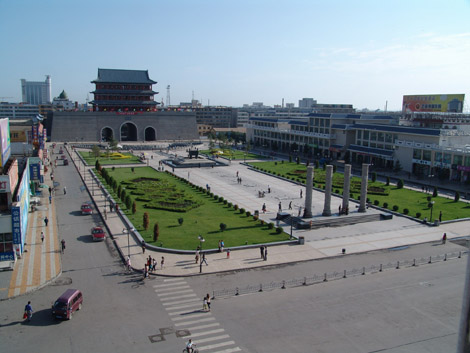more>>More News
- National Day
- ways to integrate into Chinese style life
- Should they be in the same university with me?!!
- Chinese Ping Pang Legend: the Sun Will Never Set
- A Glance of those Funny University Associations
- mahjong----The game of a brand new sexy
- Magpie Festival
- Park Shares Zongzi for Dragon Boat Festival
- Yue Fei —— Great Hero
- Mei Lanfang——Master of Peking Opera
Wuwei
By admin on 2015-01-16
 Wuwei
City 武威市, also called Liangzhou 凉州, is located in the east of the Hexi Corridor
of Gansu Province, China. She was an important section of the ancient Silk Road.
The name of Wuwei is from the “brilliant military power” of the General Huo
Qubin in the Han Dynasty to defeat the Xunnu ethnic group invader in the ancient
Hexi Corridor. Wuwei is a famous historical cultural city and opening up city,
the capital of tourist symbol of China, the hometown of the Chinese grape wine,
the witness place of Tibet belonging to China, and the unique native haunt of
the White Yak in the world. She governs Liangzhou District, Minqin County,
Gulang County and Tianzhu Tibetan Autonomous County, covers an area of 33
thousand square kilometers, and has a population of 1930 thousand, including 38
ethnic groups, mainly the Han, Tibetan, Hui, Mongolian and so on.
Wuwei
City 武威市, also called Liangzhou 凉州, is located in the east of the Hexi Corridor
of Gansu Province, China. She was an important section of the ancient Silk Road.
The name of Wuwei is from the “brilliant military power” of the General Huo
Qubin in the Han Dynasty to defeat the Xunnu ethnic group invader in the ancient
Hexi Corridor. Wuwei is a famous historical cultural city and opening up city,
the capital of tourist symbol of China, the hometown of the Chinese grape wine,
the witness place of Tibet belonging to China, and the unique native haunt of
the White Yak in the world. She governs Liangzhou District, Minqin County,
Gulang County and Tianzhu Tibetan Autonomous County, covers an area of 33
thousand square kilometers, and has a population of 1930 thousand, including 38
ethnic groups, mainly the Han, Tibetan, Hui, Mongolian and so on.
Wuweihas been famous on its important geographical position "which opens a
road through the broad desert, and controls the faucal place of the ancient
five-districts." To the east, she is next to Lanzhou city, to the south is near
Xining city, and to the north faces Yinchuan city. She is the east gate of the
Hexi Corridor, the railways of the Lanzhou-Xinjiang and Wuwei- Gantang, the
Nation Highway 312 pass through the city. The road of the province and the local
levels radiate in all directions. Wuwei has become the flourishing business
place of the commercial and trade in the Hexi Corridor because of the integrated
market system, the more floating population and the blooming purchasing
capabilities.
The special geography environment and the weather
conditions have made Wuwei quite suitable place for planting the brewing grape.
She has quite a lot in common with Bordeaux, France, on the latitude and
climate, and was called “the Bordeaux in China”.
Wuwei owns the
centuries-old history, rich cultural heritages, particular natural sceneries and
multiform ethnologic amorous -feelings. There are 543 relics and historical
sites in the city. There are about 40,000 items (volumes) of relics stored in
the museums. Among the relics, the Leitai Han Dynasty Tomb, is the place
unearthed the Bronze Galloping Horse, the Symbol of China’s Tourism, the Xixia
Monument, is addressed as “a living dictionary” by scholars from home and
abroad, the Wuwei Confucian Temple (Wenmiao Temple), named the champion of the
ancient education schools , is well known as “the top Academy of learning”, the
Tiantishan Grottoes, is considered “the senior ancestor of the Chinese ancient
grottoes”, the Baitashi Temple (White Pagodas), is the historical witness place
of Tibet belonging to China, the Haizang Temple , is the fabulous place the
Xuanzhuang of the Tang Dynasty rested for collecting the Sutras from the West,
the Luoshisi Tower, is the Holy land of the Buddhism , the Bronze Bell in Dayun
Temple , the ancient sites of the Great Wall, " three-gorges " natural sights,
Wuwei Desert Park, the Endangered-wild Animals Breeding Center, Minqin Desert
Reservoir, which is the largest one in the Asia. All of these have laid a solid
foundation for visits, exploration, and so on.
- Contact Us
-
Tel:
0086-571-88165708
0086-571-88165512E-mail:
admission@cuecc.com
- About Us
- Who We Are What we do Why CUECC How to Apply
- Address
- Study in China TESOL in China
Hangzhou Jiaoyu Science and Technology Co.LTD.
Copyright 2003-2024, All rights reserved




 Chinese
Chinese
 English
English
 Korean
Korean
 Japanese
Japanese
 French
French
 Russian
Russian
 Vietnamese
Vietnamese
